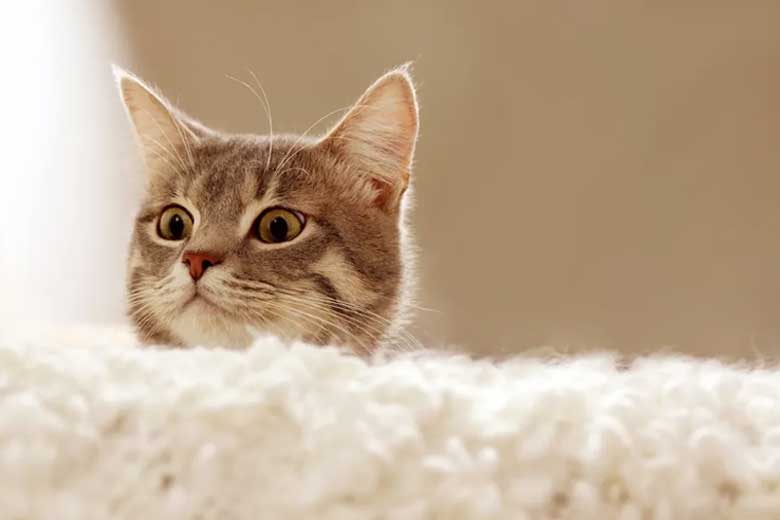Cats have been around for thousands of years. Throughout that time, they have divided people into two camps: those who see cats as selfish monsters who will never love you and continue to forever drain your resources, and those who see them as cuddly, but very demanding friends who will add a little bit of interesting spice to your life (often in the form of hair in morning coffee).
That’s why we have prepared some unique cat facts for kids. Cats are fascinating little creatures that have been stealing our favorite couch spot since forever, and we would love kids to appreciate cats as much as we do.
1. In the world, there are more than 500 million domestic cats.
2. Humans and cats have been coexisting for almost ten thousand years. In 2014, archaeologists discovered six cat skeletons buried with their owners at a cemetery in Egypt that dates back to between 3600 and 3800 B.C.
3. To preserve energy, cats sleep for an average of 12 to 14 hours every day, or almost 70% of their entire life.
4. Typically, domestic cats weigh between 4 kilograms (8 pounds) and 5 kilos (11 pounds). The record-setting domestic cat weighs 21 kilos (46 pounds).
5. Cats are sneaky and deadly hunters. When they walk, they place their back paws almost exactly in the same place as their front paws did earlier, making their tracks less noticeable and keeping the noise to a minimum.
6. Due to their excellent night vision, cats can see at light levels that are six times lower than what a human needs in order to see. Additionally, they have excellent hearing and a keen sense of smell.
7. Domestic cats enjoy playing, and this is especially true with kittens who enjoy chasing toys and engaging in play fights. Through play, kittens learn and practice fighting and hunting techniques.
8. Cats who spend a lot of time outdoors unattended live to be around 7 years old, but indoor-only cats are expected to live to be around 14 years old.
9. Cats are naturally hygienic creatures who spend a lot of time licking their coats. They don’t need as much attention as dogs do because they can take care of themselves. To further assist them in cleaning and detangling their fur, they also have small hooks on their tongues that feel like sandpaper.
10. Feral, wild cats are often seen as nuisances and dangers to local wildlife, including birds.
11. The Near Eastern wildcat, which roamed the deserts of Israel, Saudi Arabia, and other Middle Eastern nations between 70,000 and 100,000 years ago, was a predecessor of the domestic cats we know today.
According to the oldest archaeological evidence discovered in Cyprus, cats were domesticated roughly 9,500 years ago.
12. There are a few theories as to how cats become domesticated. Some people believe that cats become our friends when our ancestors started putting food out for them to visit regularly after realizing that cats preyed on rodents. Others think that because cats were simply tolerated and welcomed by people, they gradually separated from their wild cousins and started to hunt for food in and around the settlements.

13. Cats can jump up to six times their own height.
14. Cats are capable of producing up to 100 different sounds, including a variety of meows, purrs, chirps, and hisses.
A cat’s purr is thought to exploit humans’ natural nurturing instinct since it has the same sensory frequency as a baby’s cry. When cats play with each other, they don’t make the same sounds when communicating with people. Adult cats meowing is pretty unusual. Our favorite non-rent payers continue doing so in order to communicate with humans, in the same manner, that kittens meow to their mothers. It’s a cry for attention in its purest form.
15. Isaac Newton, a scientist most recognized for discovering gravity, adored his cat, Spithead. While Newton was conducting experiments, Spithead kept disturbing him by scratching at the door. It’s thought that Isaac Newton invented the cat door.
16. Jack Hetherington and F.D.C. Willard collaborated on a study that was published in 1975. The study offers an interesting and important perspective on atomic behavior and has received numerous citations… but only one of its authors is human, F.D.C. Willard is a cat. His owner, Hetherington, added his cat as a co-author when he noticed that he had used the pronouns “we” and “our” in the plural, even though he was the only author.

17. Over 200 cats live at Disneyland. Not long after Disneyland first opened its doors in 1955, Walt Disney discovered that a group of feral cats began living in Sleeping Beauty’s Castle. Although many of the cats were adopted by park staff, the majority stayed.
18. Because their coloring is linked to the X chromosome, calico (or tricolored) cats are almost always female.
19. Some cats are born with extra toes. These cats, also called polydactyl cats, have an extra toe that looks like a thumb. Sometimes they are called after Ernest Hemingway’s cat, because the author owned a polydactyl cat named Snow White.
20. Cats are unable to taste sweetness. According to a 2005 study, cats are “sweet blind”, which means they can’t taste sweetness at all. Even though they lack the taste buds necessary to taste sugary foods, scientists think that they used to have them at some point in history, but have now lost them due to evolution.
We hope that not only kids but also the eldest and wisest found those cat facts interesting.

